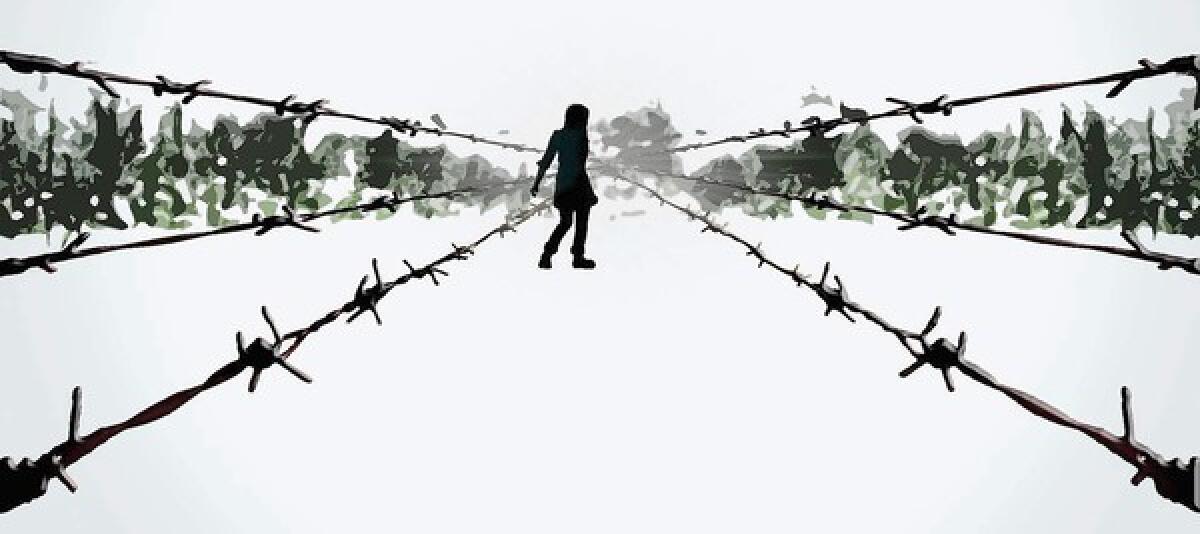Not Just for Kids: ‘Between Shades of Gray’ by Ruta Sepetys

Between Shades of Gray
A Novel
Ruta Sepetys
Philomel: 344 pp., $17.99, ages 12 and up
In young adult books about World War II, the Holocaust dominates. But there are lesser-known atrocities that also took place, including during the Soviet occupation of the Baltic states. The Soviets not only displaced countless Lithuanians, Latvians and Estonians, leaving them to die, but wiped those countries from the map for much of the last century.
It’s this story that is told in “Between Shades of Gray,” the heart-wrenching debut novel from Ruta Sepetys. Sepetys is the granddaughter of a Lithuanian military officer who himself escaped to a refugee camp during World War II. Other members of her extended family weren’t so lucky. They were deported to Siberia, forced into hard labor or imprisoned, much like the fictional characters here.
The book begins not with words but with a map. Titled “The Journey,” it shows the thousands of miles traveled by 15-year-old Lina, her 10-year-old brother Jonas and their mother, Elena, in 1941 after they were snatched from their home in the Lithuanian city of Kaunas in the middle of the night, thrown on a truck and transported across Belarus to a labor camp in Siberia and finally to the Arctic Circle.
“They took me in my nightgown” are the book’s first words. It’s a horrific scene of forced family separation. Lina’s father is missing, and the family’s terror only intensifies as her mother trades all her money and several items of jewelry to Russian soldiers to keep her two children by her side as they navigate an uncertain future.
They haven’t been told where they will be taken or why they were even on the Soviets’ list. That story gradually unfolds over the course of this elegantly written yet fast-paced novel in flashbacks triggered by the events of the family’s capture.
“Between Shades of Gray” is written retrospectively from Lina’s point of view, a subliminal indication to the reader that despite the hardships she endures, she will survive.
Lina is headstrong and an artist. The daughter of a professor, she idolizes the Norwegian artist Edvard Munch for his honesty and had hoped to attend a top-notch art academy before that dream was thwarted. In the labor camps where she was forced to dig potatoes out of the ground with her bare hands but not allowed to eat them, Lina uses drawing to channel “a sadness so deep, like your very core has been hollowed out and fed back to you from a dirty bucket.”
In writing “Between Shades of Gray,” Sepetys traveled to Lithuania twice to interview survivors of the Soviet genocide. The details of those interviews are folded into the book’s larger narrative with a sober clarity that simultaneously horrifies and fascinates, making the tragedy of the characters’ situations palpable.
Truth isn’t only stranger than fiction. Incorporated into the story line of “Between Shades of Gray,” it’s more repulsive. The daily lives of Lina and her family are punctuated by cruelty and a starvation so severe they regularly sucked the crumbs out from under their fingernails. A man who was caught eating a stolen beet was punished by having his teeth ripped out with pliers. Lina’s reward for drawing a portrait of the labor camp’s commander was a loaf of bread thrown in the dirt at her feet and a can of sardines that was pelted at her head and drew blood.
A story of hardship as well as human triumph, “Between Shades of Gray” is an eye-opening reimagination of a very real tragedy written with grace and heart.
More to Read
The biggest entertainment stories
Get our big stories about Hollywood, film, television, music, arts, culture and more right in your inbox as soon as they publish.
You may occasionally receive promotional content from the Los Angeles Times.










